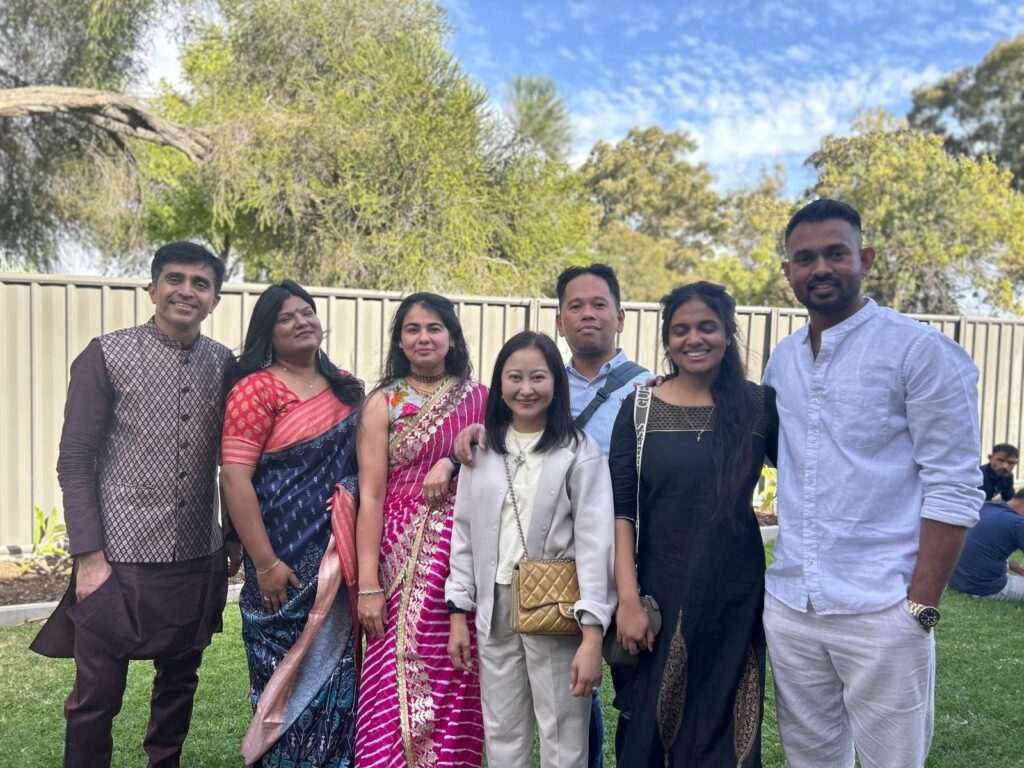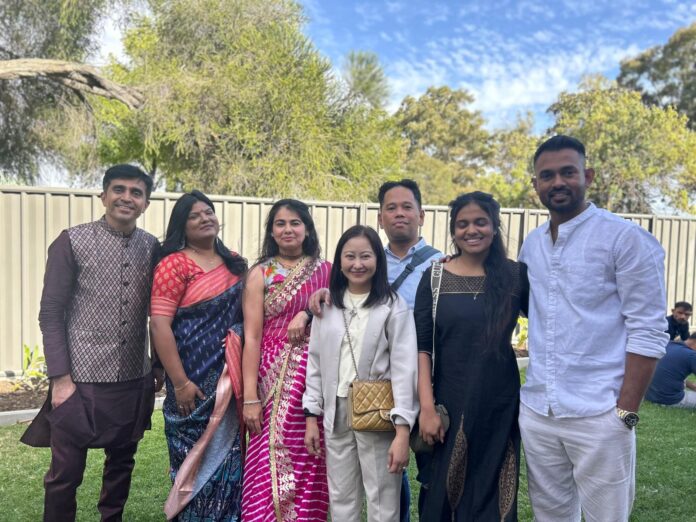As someone raised in the Catholic tradition, stepping into a Hindu temple for the first time was a moment filled with quiet curiosity, a bit of nervousness, and an open heart. I didn’t know exactly what to expect, but what I encountered was far more profound and beautiful than I could have imagined. It was a lesson in unity, devotion, and the power of community — something that transcends religious boundaries.
Table of Contents
A Sacred Environment
My wife and I were invited to a service by Kinjal, her school director at Lotus Montessori to visit ISKCON Hindu Temple at Kilburn in Adelaide’s inner north suburbs. We went there with her colleague Shihara and her husband Dasun, Mansi, her parents and children.
From the moment I arrived, the atmosphere showed welcoming to visitors. The temple grounds had folks coming in and out. The faint chant and rhythmic hum of chants echoing softly in the background became more audible as we approached.
Before entering, we removed our footwear, a gesture I quickly learned symbolised respect and humility before the divine. Earlier in the day we ensured having vegetarian diet and physical cleanliness prior to temple visit. The gesture reminded me of Moses removing his sandals before the burning bush — a sacred moment, across two very different traditions, yet speaking the same language of reverence.
I greeted others with a gentle nod, and many responded with hands pressed together in front of their hearts, saying “Namaste.” I returned the gesture — not perfectly, but sincerely. It struck me how this small act of greeting carried a deep meaning: “I bow to the divine in you.”
This wasn’t my first time stepping into a space of worship outside my own tradition. Many years ago, I visited a Buddhist temple in Bangkok with my friend Petch, and the experience left a lasting impression. The temple was quiet, almost silent except for the occasional rustle of robes or the soft gong of a bell.
Devotees moved slowly and deliberately, bowing low before statues of the Buddha, offering lotus flowers, and lighting incense sticks with deep concentration. There were no hymns, no sermons — just peaceful stillness and focused meditation.
It was a different form of devotion from what I was used to as a Catholic, but the deep spiritual longing and reverence were just as palpable. That visit reminded me that silence can be as sacred as song, and stillness can be as powerful as proclamation
Unity in Devotion
Inside the temple, a group of worshippers gathered for a communal chant of “Hare Krishna, Hare Rama.” The rhythmic repetition of the mantras, accompanied by drums and bells, created a spiritual energy that was both calming and invigorating. Though I didn’t understand the words, I could feel the sincerity of the devotion.

There was a unity among the believers that deeply moved me — people of all ages chanting, some with closed eyes, others bowing in quiet prayer. It reminded me of the unity I feel when singing hymns in a Catholic Mass, but here, it was expressed in a different tone, language, and rhythm. And yet, the spirit of connection to the divine was unmistakably similar.
Fellowship Through Service
After the prayer, I was invited to share in a meal — a simple but delicious vegetarian spread offered freely to all. I learned that this practice, called prasadam, is not just a meal but a form of service and blessing. Volunteers prepared and served the food with care and joy, without expectation of anything in return. I was offered a variety of vegetarian food — rice, chapati, papadom, and veggies — I took what was offered and scooped into my plate.
The experience reminded me of the Gospel story of the loaves and fishes — how the spirit of sharing can multiply blessings.
I watched families sitting together, laughing, sharing food, and gently encouraging their children to say a prayer before eating. There was a strong sense of family unity — of faith being woven into daily life, passed naturally from one generation to the next.
Respecting the Sacred in Others
What stood out most to me wasn’t the differences between our faiths, but the common threads — service, reverence, and community. I didn’t feel out of place or judged. We felt welcomed, even as a guest from a different tradition. That hospitality reflected a deep value within Hinduism — to honour the divine presence in all who come, regardless of background or belief.
It also reminded me of the Catholic teaching that we are all created in the image of God. Respecting the sacred in another person’s faith doesn’t mean compromising my own. It means acknowledging that God, in His infinite mystery, may reveal Himself in more ways than we can fully comprehend.
A Journey of Understanding
My visit to the Hindu temple was a spiritual encounter and not about observing another religion’s practices. It was a reminder that faith is not confined to the walls of one church or the pages of one book. There is much we can learn when we step out of our comfort zones and into the sacred spaces of others — not to compare, but to understand.
I walked away with a deeper appreciation for my own faith and a profound respect for those who walk a different path. Unity, after all, is about recognising the divine spark in each other, even when expressed in unfamiliar ways.
To our Hindu friends and to the kind souls who welcomed us — thank you. You didn’t just open your temple doors; you opened my heart to the beauty of faith in all its forms.

